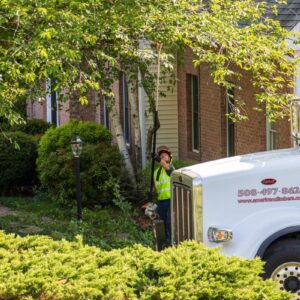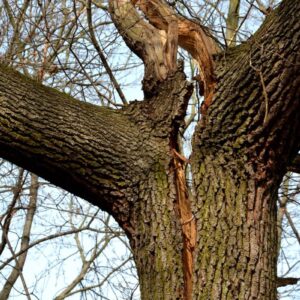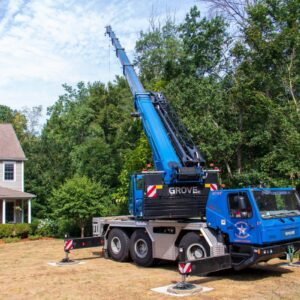When you have a tree removed, a professional tree removal company will suggest grinding out its stump if conditions around the stump base allow it. Should you opt for stump grinding? How long will it take? What are the benefits of removing a stump? Is it a DIY job you can do yourself?
We answer all of those questions about stump grinding – and more – in the article below.
What is a stump grinder?
Stump grinders are powerful machines that look—depending on their size and model—a little like a lawnmower and a circular saw had a baby together. They’re designed to be rolled up to the stump and then grind it into little pieces.
How does stump grinding work?
A stump grinder chews away at the stump wood that’s left after a tree has been cut down. All stump grinders use a powerful, rotating blade that rips into the wood as it turns. The blade’s teeth cut the stump wood into small pieces. The operator guides the blade over the entire stump as the blade reduces the wood to chips, and takes the stump down to well below ground level.
What happens to the wood from the tree stump after grinding?
Stump grinding results in lots of chips of wood. You’ll make more of them than you think, but they can be used as mulch on-site or added to your green waste can. You’ll also have a hole, since you’ve just ground out all the stump volume that filled it. You can shovel the wood chips into the hole to decay, or you can import soil and fill the hole so that it’s even with the surrounding ground.
 What types of stump grinders are there?
What types of stump grinders are there?
You can find lightweight grinder models for small jobs, as well as big, powerful grinders for large stumps and complex logistics. The types of stump grinders include:
- Hand-guided, walk-behind, or “handlebar” grinders are small and lightweight. Their small size makes them the most portable, as they’ll fit in the back of a truck.
- Rear-hitch, wheeled stump grinders can be attached to a truck or trailer for travel and are then uncoupled at the job site and steered into place.
- Riding grinders are agile, like a bobcat or small tractor, with the operator controlling the grinder from a seat.
- Skid stump grinders have continuous track treads like a tank, and are driven from behind, or by an operator riding atop. The continuous treads grip large surface areas and are used where the ground is soft and traditional wheels would churn up soil or turf.
- A stump grinder attachment can be added to a skid steer, where it will be operated by the same arms that guide its trenching or bucket attachments.
As with most powerful equipment, stump grinders are designed specifically for their purpose.
Is a stump grinder the same thing as a stump remover?
Stump grinders are different from stump removers, as a stump remover is auger-like and bores down into the stump from above, removing all trunk wood and anchoring roots.
Can I rent a stump grinder?
Stump grinders that are available for rent by homeowners will be smaller and less powerful than those used by professionals and it’s unlikely you’ll find a range of stump grinder models to choose from.
DIY = DON’T INJURE YOURSELF
Stump grinders are generally used by professionals, such as trained tree-care specialists. As with most heavy, powerful equipment, the chance for injury is high. DIY homeowners should be sure of their skill before picking up a stump grinder.
In addition to working the machine itself, operators need protective equipment to protect them from noise and from flying debris. Debris can be sharp pieces of wood, but also anything else that might be hiding in the ground: old fence posts, old piping, bricks, glass, nails, or lost tools.
Professional arborists and tree-removal companies also carry insurance against accidental damage to property from tree removal and stump grinding. A DIY’er should think about the possibility of this and make sure they have insurance that will cover any damage to their own and their neighbor’s property.
Is renting a stump grinder worthwhile?
A small, lightweight rented grinder means more time and physical effort for you, and your stump may be too large for a rental grinder to handle. And, as anyone who has rented machinery knows, there’s no guarantee that the equipment is in good working order, or even safe to operate.
What should I consider if I plan to rent a stump grinder?
If you’re thinking of DIY-ing your tree stump, you might first want to add up the time and cost of renting a stump grinder, including:
- A vehicle to transport it to and from the rental yard
- Gas to power it
- Personal safety gear for you
- Strength to load, unload and move the grinder
- Strength to maneuver the grinder
- Materials to protect the surrounding ground from damage
- Material or screen to stop flying debris
- Chance of damage to the rented grinder blade teeth from hidden debris
- Debris cleanup and disposal
- Homeowner’s liability insurance coverage
If you compare what you’ll need to do against the time and cost of having your stump professionally removed, you may find that the professional option is the better choice. We’re experienced, fast and efficient, we have a trained crew and professional equipment, we’ll make wood chip mulch for you, and we’ll clean up after ourselves!
Can a tree be removed without leaving a stump?
Tree-removers can’t cut a tree down flush with the ground, so there will always be a stump.
 Does a tree stump need to be removed?
Does a tree stump need to be removed?
It’s your decision, but you may want to learn more about what to expect if you don’t remove the stump after you remove your tree.
Many homeowners can’t anticipate how much a left-over tree stump will stand out after a tree is removed, especially if the rest of their garden is tidy and maintained. Grinding out the stump, by comparison, gives you a clean slate for future landscape design.
Because it chews stump wood down below ground level, a stump grinder ensures that your tree stump won’t re-sprout with suckering growth around its perimeter. This is often the best argument for stump grinding; leaving a stump in place can mean repeated sucker pruning, a garden chore that offers little satisfaction, as you’re never done.
While suckering sprouts are a natural response by the tree after its trunk has been cut down, none of this growth is useful and won’t make a healthy new tree. Instead, you’ll have lots of sprouts that turn into branches that will need to be cut down over and over until the tree exhausts its energy reserves. This can take a long time.
NOTE: Coppicing is an ancient practice where woodland or forest tree trunks are cut down to ground level and new sprouts are encouraged to grow from them. Depending on a tree’s species, the new, sprouting wood grows until it’s harvested for firewood, fencing, thatching, or woodworking. On a healthy coppiced tree, these cycles of growth and harvesting can go on for decades and longer. But chances are you won’t need this in your yard!
A leftover stump doesn’t always have to be removed, but ask yourself if you want to look at a tree stump for years to come, or deal with its suckering growth.
Depending on its size, height, and location, a stump may be an eyesore (especially as it slowly rots away), and it also may become a tripping hazard. It can also attract insect pests, develop fungal diseases (that can spread to nearby trees), and cause soft, sunken spots in the surrounding lawn or garden as it decomposes.
On the other hand, a stump can become part of a funky garden design, can be used as an informal base for potted plants or sculptures, and can be painted, decorated, or sculpted.
 Can I build or pave over the area where a stump was ground out?
Can I build or pave over the area where a stump was ground out?
One important consideration is whether or not you plan to build where the tree stump is, or add a patio or paving. Because a tree stump is wood, an organic material, it will decompose over time. This means that it isn’t a stable base material for construction, and any foundations, footings, or rigid materials will move over time.
So even if your stump is ground out, there may be trunk and root material left below ground that will decay and settle, damaging your construction. In this case, you’ll want to make sure all remaining stump and roots are removed and that the hole is in-filled with native soil (not bagged potting soil), and then compacted to the level required for construction.
Are there situations where a stump cannot be ground?
Most easily-accessible trees that are removed can also have their stumps ground out. Sometimes a stump has to be removed for safety reasons, or because it blocks access. But there are situations where stump removal may be difficult or impossible.
- Hard-to-reach trees in places where access is limited or where equipment is too large to bring in may not be candidates for stump grinding
- Stumps that can’t be fully removed by grinding can be ground first and then pulled out with a skid steer or an excavator; this adds cost but may be the only way to go.
- Trees that were growing in small planting holes surrounded by concrete or other hardscape materials may leave behind a stump that can’t be removed without damaging the surrounding material, or the material may need to be removed first. This can be costly or impossible.
- A tree stump that’s close to other trees or valuable shrubs may damage these other plants and their root systems if their stump is ground out.
- Stumps that are close to buildings or other structures may be hard to grind out because of the chance of damage to foundations, footings, or underground utilities and pipes.
It’s best to check for hidden liabilities before starting to grind a stump, especially if you DIY.
What are the alternatives to stump grinding to remove a tree stump?
If you have a very small stump, you may be able to remove it with hand tools. Having a stump with a few feet of trunk left on is useful here, as the trunk can be used as a lever to help loosen the trunk. You’ll first use a shovel or a pick axe to loosen and dig out the soil around the stump to expose its roots. After you’ve uncovered the roots, you can use gravity and your body weight to rock the stump loose. If you have loppers or a pruning saw, you can use them to sever large roots and help free the trunk. This is strenuous physical work, but it’s not impossible.
You’ve probably seen bottles of chemical stump remover at your nursery or hardware store. These products are often made of potassium nitrate, and work by speeding up wood decay. They require that you drill holes into your stump, fill them with stump killer, add water, cover your stump, and wait.
Potassium nitrate isn’t poisonous, but it can cause minor eye and skin irritation, and you’ll want to keep children and pets away from it and your stump.
Another way people remove stumps is to pour kerosene over a stump and light it on fire. Please, don’t be the person who thinks a flaming tree stump is a good use of time and resources.
IF YOU NEED TO HAVE A STUMP REMOVED
Call us first. We can evaluate your situation and give you an estimate of how much it will cost to remove the tree stump. You may be surprised at how affordable it is. Most stump removal is fast, and even large stumps usually take only a few hours.
We always offer our stump removal services when we remove a tree, including explaining the benefits of having your stump removed professionally and describing the benefits of tree-stump mulch for your garden.
Blog Topics
Recent Posts
What's Happening? Stay Informed!
Stay on top of local events, pest and disease updates, tree and landscape tips, and more. Delivered straight to your inbox each month.

 What types of stump grinders are there?
What types of stump grinders are there?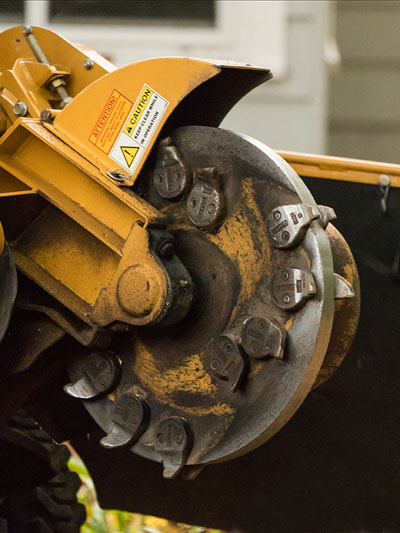
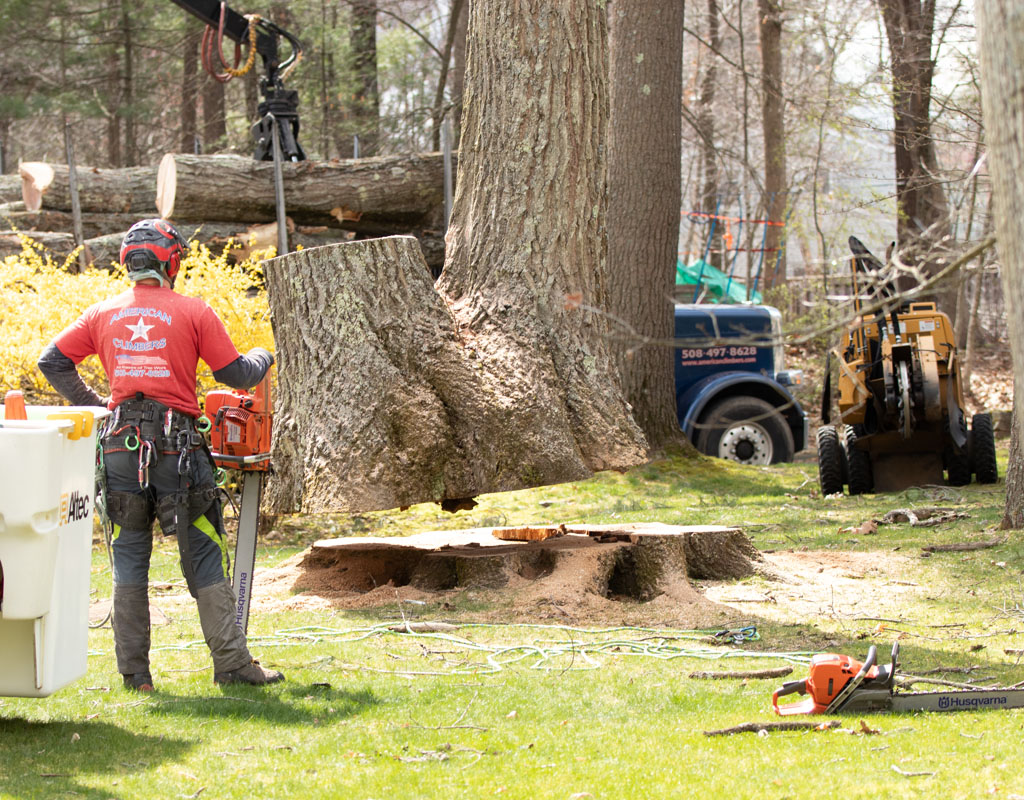 Does a tree stump need to be removed?
Does a tree stump need to be removed?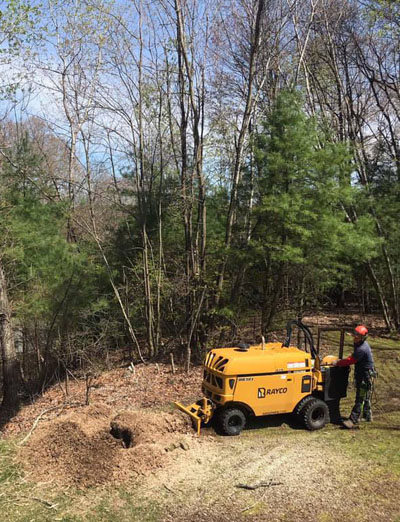 Can I build or pave over the area where a stump was ground out?
Can I build or pave over the area where a stump was ground out?

